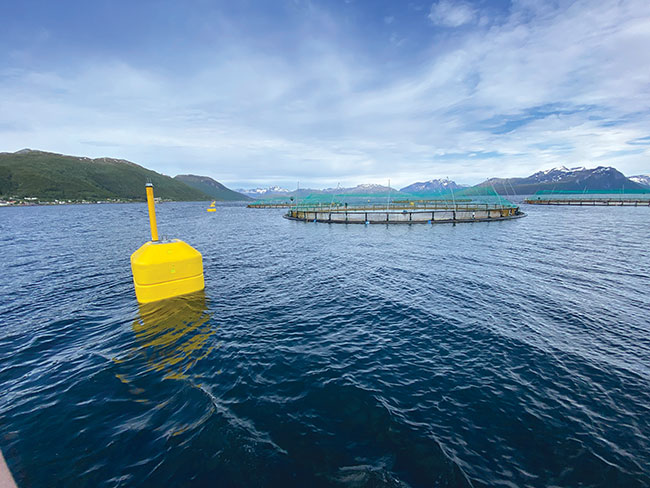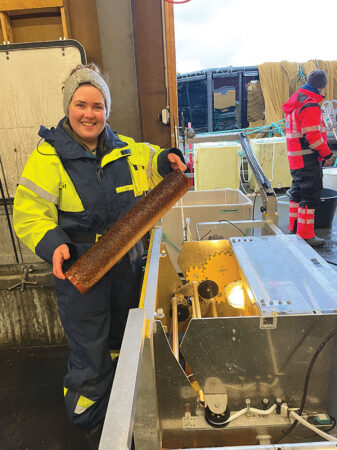
Better together: Kelp and Salmon
May 3, 2023
By Lynn Fantom
Folla Alger and Cermaq combine kelp and salmon at new sea site, “dynamic” research opens to others
 The combined kelp and salmon site in Norway will host a variety of research trials.
Photos: SINTEF
The combined kelp and salmon site in Norway will host a variety of research trials.
Photos: SINTEF The world’s first industrial-scale sea site built for the combined production of salmon and seaweed will harvest its first kelp in June, but it began reaping research data as soon as it was stocked in February. And it is open to other groups to conduct their own experiments.
“We really welcome other universities, industry researchers, and students to come and use this site,” said Aleksander Handå, a senior research scientist at SINTEF Ocean AS, who is serving as project leader. In cooperation with Norwegian University of Science and Technology (NTNU) and Nord University, SINTEF is responsible for research on the project.
Located in northern Norway, the farm represents a collaboration between Folla Alger and global salmon producer Cermaq. Founded by entrepreneurs with experience in aquaculture, public governance, and finance, Folla Alger was launched specifically to explore integrated kelp and salmon production. It was granted research and development licenses from the Directorate of Fisheries to carry out this project.
“This is a dedicated site for combined production. It’s not a standard salmon site that is slightly modified. It’s a newly designed, fully integrated farm from scratch,” said Handå.
The site features 24 traditional net pens for Atlantic salmon that conform to Norwegian standards. It is configured with grids of four fish cages at end points, with sugar kelp (Saccharina latissima) grown in between. This set-up allows the kelp to use the nutrients released by the salmon.
“We know that we can get up to 50 percent better kelp growth by cultivating it together with farmed fish. Now we will also look at whether there are more advantages to a combined operation,” noted Silje Forbord, the project’s research manager.
“We are monitoring the fish health. We are monitoring the microbiota of the kelp and the fish to see if later on there are some new discoveries or some correlations—something that we are not necessarily aware of today,” Handå added. “It’s a very dynamic project.”
Achieving the best match
SINTEF has been performing studies in integrated multi-trophic aquaculture (IMTA) for over a decade. A key finding is that co-production of salmon and kelp reduces the ecological impact of dissolved nitrogen and phosphorous released into the ocean at a salmon farm, thus providing an environmental benefit.
Small-scale IMTA studies have also provided incremental insights, for example, into seasonality. When differences were found in the elemental, biochemical and lipid composition of kelp, it was due to harvesting period and not the distance to fish farm sea cages. That allowed researchers to conclude that integrated multi-trophic aquaculture setups do not compromise nutritional quality of kelp, even while increasing yield.
Researchers also learned that kelp’s peak growth periods in southern and central Norway occur in late spring and early summer—but later in waters further north. Peak nutrient release from the salmon farms takes place in August and September. That’s also a time of year when there are fewer nutrients in the sea in general.
So, it was decided to site the Folla Alger and Cermaq trial further north. “You have the growth of the seaweed coinciding better with nutrient emissions. Hopefully, they will match up in the area where we are now testing,” said Handå.

In February, these kelp spools seeded carrier ropes at the sea site.
The big picture
“Fish farming and kelp farming are both industries for the future and will be important contributors to the green shift,” said chairman of Folla Alger Tarald Sivertsen in a press release. Integrating them at the same site is a move toward the proposition of a circular economy: in this case, where fish nutrients benefit kelp growth and kelp, in turn, might become a component of fish feed.
In addition, combined farming like this can provide better area use in the ocean. “The project contributes to increased local value creation and business development, which is very positive for everyone who lives and works here,” added Truls Hansen, Cermaq’s production director in Nordland, the county in northern Norway where both this new site and some other Cermaq sea farms are located.
The project is addressing feeds for both aquaculture and agriculture, such as cattle or hogs.
Although kelp itself may have limitations as a salmon feed ingredient, SINTEF research suggests that it could serve as a diet for various marine worms—aimed for salmon feed. These lower trophic organisms, which are rich in marine lipids, essential amino acids and micro- and macronutrients, have the potential to supplement or replace protein concentrates from imported soy.
And there are more possibilities. Could kelp inclusion in salmon feed have immune-stimulating benefits? Alginates are derived from brown seaweeds like kelp—could they be used to improve binding in salmon feed pellets and reduce waste?
“This is very, very early, but, of course, in general, feed production is a goal, as well as using the nutrients in a recycling setup like this. We look to ways to create a new bio-economy and hopefully contribute to making fish farming and aquaculture practices in general more sustainable,” said Handå.





